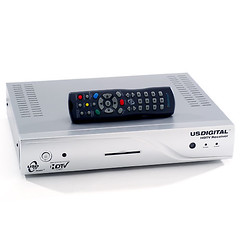...and giving to the poor. The US Digital HDTV Tuner was the first high-definition tuner at WalMart when it came out a year ago, but it had a secret inside waiting to be unlocked. Its video output supports every analog format from HD component to standard composite so even regular television owners could benefit from this product. A digital audio output was present for surround as was traditional stereo jacks. All of this was fed through a single UHF antenna port.
The tuner works as an ATSC or high-definition decoder for free but the magic was that in select markets, for a mere $19.95 per month, Fox News, Discovery, Disney and about 30 other "cable" channels can be received. The signals for these channels are broadcast over unused capacity within the HDTV UHF spectrum using technology from DotCast. HDTV frequencies are 6MHz wide and offer 27mbps of throughput. The FCC requires that an HDTV channel use only up to 19.4Mbps of bandwidth so that leaves a bit extra for USDTV to lease and combine with partially used channels over remaining spectrum from each broadcaster in a region. DotCast developed this multiplexing technology to spread data across many channels as a way to download programs to computers or set-top boxes. With USDTV, this "video data" is decoded with an ATI NXT2004 as standard definition video programming from a VSB/QAM tuner. This is sent to the TV by way of a ATI Xilleon chip running at 300MHz, which handles the AC3 and MPEG2 decoding. The only connection that you need to receive their signal is a bow-tie or external UHF antenna. No cable feed or even satellite dish aiming is required. This also means that rain fade should be non-existent as well. All that you need is a strong UHF signal to your home, or an antenna suited for its reception.
This is an interesting concept, as USDTV has created an MVNO model for television. Think about all of the money that your local broadcast networks spend to keep their broadcast towers up and online. An even more expensive undertaking is keeping Murdock and Ergen's DirecTV and DISH Network satellites in a 22,300 mile orbit in space. USDTV can ride on the backs of infrastructure that is already in place and their only cost is customer acquisition and programming. It worked well for Virgin Mobile, Boost and hopefully the just released Amp'd. There are some TV affectionado's who are concerned that HDTV quality will suffer as broadcasters supplement their revenue stream with data casting, but most markets that are using the technology get a majority of their bandwidth from digital networks owned by PAX, which only programs in standard definition - leaving plenty of bandwidth for USDTV. The jury is still out on whether they can be successful in the market place, but with a great channel selection, low cost and inexpensive hardware, they have all of the things going for them including the ability for the end user to "self install." Now that is scalable!
Tuesday, November 29, 2005
Subscribe to:
Post Comments (Atom)


1 comment:
I own one of these boxes as well. I didn;t think I could use it anymore since the company went out of business. Are you still using yours?
Post a Comment